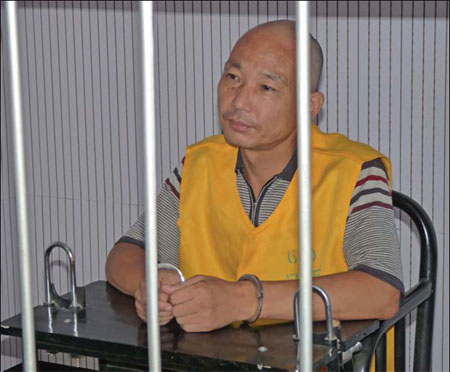Tomb raiders remain a menace
Updated: 2011-09-09 14:26
By Zhang Yan (China Daily European Weekly)
Recent raids
Past cases of tomb raiding show how difficult it can be to guard historical graves but also give reason to hope that stolen cultural artifacts can be recovered.
In August, four men were detained by police for excavating ancient tombs in Danfeng county in Shangluo, a city in Shaanxi province.
The suspects, who ranged in age from 30 to 50, came from Henan and Shaanxi, lending weight to authorities' belief that criminals from the bordering provinces are working together.
The four members of the alleged gang, headed by Pan Liusuo, 48, who hails from Henan, hired three villagers from the same province to help them in the theft. They also gained the complicity of a villager in Danfeng county, who agreed to unearth the historical tombs and share whatever booty was discovered.
|
 Pan Liusuo, a 48-year-old suspected gang leader from Henan, is detained at the Danfeng county detention house on suspicion of tomb raiding. [Photos Provided to China Daily] |
On Aug 16, when they began to dig a hole at one gravesite, they were come upon by a team formed to patrol the graves. Believing them to be members of a criminal gang, the team immediately called the police, who rushed to the site and detained the suspects.
Pan Baocheng, a 53-year-old gang member from Henan, told China Daily he became a criminal simply out of greed.
"I just thought it would be a quick way to become rich," he said. "When I was detained by the police and lost my freedom, I began to reflect and then realized that I had committed a serious crime."
"I sincerely implore other criminals who are eager to raid tombs to think that when they break the law, no matter how much money they get, they will be severely punished sooner or later."
In March, the Ministry of Public Security and the Xi'an police succeeded in persuading two relics collectors in the United States to return a 27-ton coffin and five first-class murals, which were taken in 2006 from the tomb of Wu Huifei (699-737), a concubine of Tang Xuanzong (685- 762), the seventh emperor of the Tang Dynasty .
The pieces had been stolen in February 2006, when a criminal gang raided a Tang Dynasty imperial tomb in a southern suburb of Xi'an.
Following an investigation, the Xi'an police caught Yang Bin, who was later found guilty of leading a criminal gang that raided tombs.
After four years of searching for the stolen treasures, authorities found them in the possession of two collectors in the United States, who were eventually persuaded to return them to the Shaanxi History Museum.
Do the crime
Those who are caught stealing artifacts face stiff penalties. If convicted of breaking into ancient cultural sites or tombs that have historical, artistic or scientific value, criminals will receive from three to 10 years in prison and fines, Li Guifang, vice-director of the All China Lawyers' Association's criminal defense department.
If their misdeeds are considered serious, they will spend from 10 years to the rest of their lives behind bars, he said. An amendment to the country's criminal law, adopted in May, makes those punishments stop short of the death penalty.
But before punishments can be considered, criminals must be caught.
Wu acknowledged the police often find it difficult to collect evidence from cases of artifact theft. And most historical tombs are difficult to guard because they occupy large areas, Wu said.
"The majority of the clues we get come from reports made by local cultural departments or villagers," he said.
"Usually, when we arrive at a crime scene, a tomb has been broken into a long time ago. So it's really difficult for us to catch suspects, find stolen loot and completely eradicate these gangs."
E-paper

Way over the moon
After an outcry several years ago about wasteful packaging, it seems that the mooncake makers of China have seen the light.
Tasting the new tapas
Mountains to climb
Short and sweet
Specials

China at her fingertips
Veteran US-China relations expert says bilateral ties have withstood the test of time

The myth buster
An outsider's look at china's leaders is updated and expanded

China in vogue
How Country captured the fascination of the world's most powerful fashion player
